Culture of Uruguay
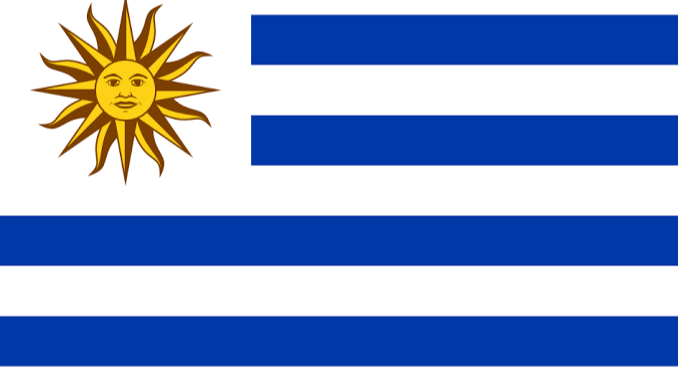
Culture Name
Uruguayan
Orientation
Identification. The name Oriental Republic of Uruguay República Oriental del Uruguay, derives from the fact that the country lies east of the Uruguay River, a major tributary of the Rio de la Plata estuary. Before independence, it was known as Banda Oriental del Uruguay . The name "Uruguay" is a Guaraní word meaning "river of shellfish," or "river the uru birds come from."
Uruguayans have a strong sense of national identity and patriotism. There are no alternative traditions or nationalities within the country.
Location and Geography. Uruguay is on the southeastern Atlantic coast of the Southern Cone of South America, bordering Argentina to the west and south and Brazil to the north. The Atlantic Ocean is on the east and the estuary of the Río de la Plata is on the south. The land area is about 68,020 square miles (176,220 kilometers).
Most of the country consists of gently rolling plains interrupted by two ridges of low hills. The remainder consists of fertile coastal and riverine lowlands, including a narrow sandy and marshy coastal plain. The many beaches are an important tourist attraction.
The climate is generally mild, and freezing temperatures are almost unknown. Because of the absence of mountains, all the regions are vulnerable to rapid changes in weather.
Grasslands and agricultural lands cover the majority of the country. There are also some limited extensions of gallery forests and palm tree savannas. The main cultural differences are related to rural (9 percent) versus urban populations (91 percent), and whether people live in the capital or the interior towns. The country is divided into nineteen administrative departamentos, each with a capital town. About half of the population lives in the capital, Montevideo, and its metropolitan area.
Demography. The total population is approximately 3.3 million. About half of the population lives in the capital, Montevideo, and its metropolitan area. The second largest city, Salto, has ninety thousand inhabitants. Much of the hinterland is very sparsely populated. As a result of emigration, there could be as many people of Uruguayan descent living outside as inside the country.
Most of the indigenous population was exterminated by the nineteenth century, and those who survived were assimilated. The ethnic composition of the population is 90 percent European (predominantly Spanish and Italian), and 6 percent of the people are partly of Native American descent. Africans, 4 percent of the population, mainly in Montevideo, were imported as slaves to work in the ports, in the processing of meat and hides, and as servants.
Linguistic Affiliation. The prevalent language is a variety of Spanish known as Rioplatense or Platellano . In rural areas, gauchesco/criollo, the creole dialect spoken by the eighteenth- and nineteenth-century gauchos, is still influential. Gauchesco has been preserved in literature, music, and jokes, and is part of the national identity. Along the Brazilian border, a local dialect called portuñol or brasilero is spoken. It is a mixture of Spanish and Portuguese. English has influenced the language of technology and the slang used by young people.
Symbolism. The color sky-blue ( celeste ) is a powerful symbol that represents freedom and independence. It is present in the four horizontal stripes of the flag that alternate with five white ones (a sun with a face in the upper corner also symbolizes independence). It is also the color worn by the national soccer team.
Soccer is the national sport and occupies a central place in the life of the nation. The entire population
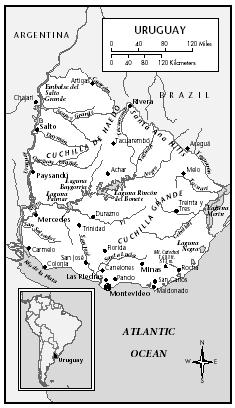
Uruguay
is united behind the national combined team, but fans' allegiance is divided among the rival local teams (Peñarol and nacional are the most popular ones). Many figures of speech and cultural metaphors revolve around soccer.
Another central symbolic element is the figure of the gaucho. The original gauchos were an equestrian ethnic group similar to North American cowboys and Ukrainian Cossacks. Cattle and horses introduced by the Spanish in the sixteenth and seventeenth centuries multiplied in the grasslands and roamed freely over the land. Some Spaniards became seminomadic exploiters of this resource, and local native residents also learned to ride horses and live off wild cattle.
Gauchos originated as mestizos in these prairies (pampas) of southern South America. Originally, they were equestrian hunters of cattle for hides, beef or salting, and horses for riding. Later they traded in contraband, worked on the cattle and sheep ranches, and served as militia during the struggle for independence and as mercenaries for post-independence caudillos . The gaucho image has become the embodiment of the national character. The idealized gaucho is strong, brave, loyal, proud but humble, honorable, generous, straightforward, clever, patient, wise but melancholic from hardship, and free and independent. The Charrúa, a dominant fierce and independent regional First Nation, although annihilated by the Europeans, is imagined to still live in the spirit of the gaucho mestizo and the Uruguayans (who sometimes called themselves "charruas").
The national flower is the ceibo and the most symbolically significant tree is the ombu . The terotero bird is a common literary symbol for the audacious, bold, attentive, and vivacious nature of the gaucho.
Another important symbol is the historical figure of José Gervasio Artigas, who is considered the father of independence and political nationalism. All political parties refer to Artigas in their platforms. Artigas' flag is still used as a patriotic symbol and was adopted by the Tupamaros. The number 33 has nationalistic connotations, being related to the 33 Patriots ( Los 33 Orientales ), a group that fought for independence.
History and Ethnic Relations
Emergence of the Nation. The colonial period from 1516 to 1810 was characterized by a struggle for control of the area by Spain and Portugal, with minor incursions by the British and French. It was during this time that Montevideo was founded (1726). Between 1811 and 1827, during the wars of independence, the formation of the national identity materialized around the epics of Artigas and the 33 Orientales. In 1828, Uruguay gained independence as a buffer state between Argentina and Brazil. Until the early twentieth century, the country engaged in an internal contest for political power through civil wars, dictatorships, and caudillismo . Polarization of the contending factions resulted in the formation of two opposing parties: the Blancos and Colorados.
In the early 1900s, under the leadership of President José Batlle y Ordóñez, the nation achieved political stability and implemented social reforms. A period of prosperity that lasted until about 1950 transformed the country into "the Switzerland of South America." Change in the international markets and an oversized government created economic hardship in the 1960s. Political instability ensued and, compounded by civil unrest and the appearance of the Tupamaro guerrilla movement, culminated in a coup and a military dictatorship in 1973. The new democratic period started with the 1984 presidential election. Since that time, the Blancos and Colorados have alternated in controlling the presidency.
National Identity. The national identity is a historical blend resulting from the struggle to maintain freedom from Spain and later from Argentina and Brazil, the gaucho culture, African slave roots, political caudillismo; and a European cultural and intellectual model.
Ethnic Relations. Uruguayans maintain harmonious ethnic relations internally and externally. They are well received in neighboring Argentina and Brazil as tourists and immigrants, and there are no ethnic tensions within the country.
Urbanism, Architecture and the Use of Space
Montevideo is a modern city with a European flavor. The character of the old part of the city, which was originally within a defensive stone wall, has been preserved to some extent. There are many parks, some very large. Public spaces follow the Spanish model and are open to everyone. Brick and mortar and concrete and stone are the dominant construction materials.
The urban centers in the interior are much less imposing and lively. Of note are the historic quarters of Colonia del Sacramento (founded in 1680 by the Portuguese), which UNESCO has declared a World Heritage City. The beach resort towns and cities are modern and active in the summer; Punta del Este has become a center for international meetings, golf tournaments, and film festivals. In remote rural areas, some gauchos still live in the traditional rancho, a simple adobe construction with a thatched roof.
Food and Economy
Food in Daily Life. Meat, particularly beef, is the mainstay of the diet. The national dish is the asado (barbecued meat). The parrillada (beef and entrails) is the most typical dish. It contains a varied assortment of parts, the most common being beef ribs, kidneys, salivary glands or sweetbreads ( mollejas ), small intestine ( chinchulines ) or large intestine ( tripa gorda ), and sweet blood pudding sausage ( morcilla dulce ). Pork sausage usually is served as an appetizer. Barbecued lamb is consumed in large quantities, particularly in rural areas. At rural banquets, entire cows are barbecued slowly with their hides.
As a result of Italian immigration in the late 1800s and early 1900s, pasta is a national food. Sunday is the preferred day for eating pasta. Most home cooking has a Spanish influence, and meals almost invariably include soup.
A standard fast food is chivito, a substantial steak sandwich. Another unique snack is wedges of fainá a chickpea flour pancake.
People eat a lot of bread and ship biscuits ( galleta marina ), mostly made of white flour, and many consume dairy products, including the national dessert, dulce de leche. Other popular desserts are pastries, milk and egg pudding, and rice pudding.
Mate which is a strong tea-like beverage made by infusing coarsely ground leaves of Yerba Mate with hot water in a gourd and sipped through a metal straw with a terminal filter ( bombilla ), is drunk at home, at work, at the beach, at soccer games and in public places. Coffee is drunk as espresso or with milk. Tea usually is drunk with milk.
Breakfast is a light meal. Traditionally, lunch and dinner are the main meals. Wine and beer commonly accompany the main meals.
Food Customs at Ceremonial Occasions. More elaborate meals are eaten at anniversaries, birthdays, promotions, and other special occasions. People take advantage of any event or occasion to eat their favorite dishes or have an outdoor barbecue. The most important special meal of the year is the Christmas Eve dinner.
Basic Economy. Services and export-oriented herding and agricultural production and industry, a relatively even distribution of income, and high levels of social spending characterize the economy. The main natural resources are pastures (more than 75 percent of the land), agriculture (10 percent of the land), hydro power, and fisheries. Mineral resources are scanty, and the country does not produce petroleum.
From the earliest period of settlement, the economy offered few employment opportunities, for it was dominated by the exploitation of grazing livestock. Large ranches (estancias), were overseen by a small number of herdsmen under the supervision of a steward. In many cases the landlord was absent most of the time, living in an urban center. Raw
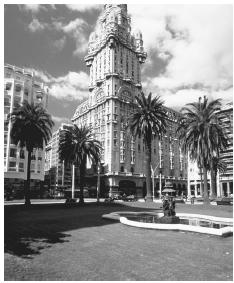
Spanish-style plazas are a common meeting place for Uruguayans.
wool and beef still represent about a third of exports by value, but sheep and cattle products account for more than 90 percent of exports.
Three-fifths of the economic output is produced by a well-educated workforce in the service sector, mainly in public services and tourism. As a result of welfare state social policies and political favors in the past, there is a disproportionate number of public servants and retired citizens, and only around 32 percent of the population is economically active.
The government owns and operates the railroads, the national airline, a shipping fleet, the telephone and telegraph system, petroleum and alcohol refining and processing, and the cement industry. However, privatization has become more prevalent. The currency is the peso. The exchange rate fluctuates, sometimes markedly.
Land Tenure and Property. Most land is privately owned, and more than half the territory is divided into large landed ranches that belong to a few families. These properties began to be fenced after the introduction of wool-producing sheep. Historically, land was obtained through titles given by Spanish and Portuguese representatives, distributed by caudillos, or informally occupied. Legal land titles now are registered.
Commercial Activities. The major agricultural products are wheat, rice, barley, corn, sorghum, sugarcane, potatoes, and fruits. The bulk of livestock are cattle, sheep, and horses. Pigs, chickens, turkeys, and rabbits are also significant. Fishery is a major economic activity, and there is some mussel aquaculture and seal harvesting. The major exports are meat, leather products, wool, rice, dairy products, and hydroelectric power. The main imports are vehicles, electrical machinery, metals, heavy industrial machinery, and crude petroleum.
There is a good highway system and some railroads and waterways. There are ports and harbors at Montevideo, Colonia, Punta del Este, Fray Bentos, Nueva Palmira, Paysandu, and Piriapolis.
Major Industries. Industry became a significant factor in the economy in the second half of the twentieth century. This sector manufactures primarily food products, petroleum products, alcoholic (mainly beer and wine) and nonalcoholic beverages, chemicals and chemical products, textiles, clothing, hydraulic cement, gypsum, tobacco products, electrical appliances, and transportation equipment.
Trade. Uruguay is part of the Mercado Común del Sur (Mercosur) free-trade area. Almost half the country's exports go to Argentina and Brazil. Other significant export recipients are the European Union countries (20 percent) and the United States (7 percent). Imports come mainly from the Mercosur partners (43 percent), the European Union (20 percent) and the United States (11 percent).
Division of Labor. Among people 14 to 55 years old, 61 percent are economically active. Among those working, 12 percent are in the primary sector, 25 percent in the secondary sector, and 63 percent in the tertiary sector. Schooling is obligatory, and children are not in the workforce.
Jobs in rural areas often are obtained though historical connections among families or through the system of compadrazgo, in which the children of rural workers are given a godfather or godmother from the local elite when they are baptized. The father and the godfather become compadres, and the mother and godmother become comadres. This symbolic kinship system is intended to assure help later if the child becomes an orphan and for preferential treatment in employment. The obligations of the godchild include loyalty in disputes with neighbors and voting.
Industrial jobs are supposedly granted on the basis of qualifications, but since major industries are government-owned, many openings are filled through partisan connections with the political party in power. This practice is particularly important in appointments for public positions. This has resulted in an oversized government workforce.
Social Stratification
Classes and Castes. Uruguay has long had a high standard of living, and its social, religious, political, and labor conditions are among the freest in South America. The state has provided universal free education since the late 1870s. However, there is social polarization; 13 percent of people in Montevideo and 16 percent in the interior live below the poverty line, and the unemployment rate is high. The relatively small upper class includes the ranching, business, professional, and political elites.
The two major minorities—the mestizos and the African-Uruguayans—are overwhelmingly in the low and lower-middle classes. During the wars for independence and later struggles for power, those ethnic groups were recruited into the militias, and they still often join the armed forces. Many African-Uruguayans are employed in domestic service or work as musicians and entertainers. There is no overt bigotry against minorities.
Symbols of Social Stratification. Montevideans stress their closeness to Europeans in appearance and life styles. Upper-class and middle-class people are very conscious of grooming and dress. In rural areas, many people still wear gaucho-influenced clothing. There is an inverse correlation between social class and the use of slang and gauchesco words. Car ownership is still seen as a social class symbol, and being a fan of certain soccer clubs also is said to be related to social class. Belonging to exclusive clubs is a symbol of social status. Where people spend their summer vacations and the beaches they go to are also related to social status.
Political Life
Government. Uruguay is a republic characterized by the presence of representative democracy at all levels of government; elections are held every five years. People are generally well informed about politics, and voting is compulsory after the age of eighteen. The election for president is unique in that the primaries and the voting occur simultaneously. People vote for candidates on open lists from each party; those who receive the most votes are the official candidates, and the presidency goes to the party with an absolute majority of votes.
The executive branch consists of a president and twelve appointed ministers. The legislative branch consists of a bicameral general assembly with ninety-nine representatives and thirty senators and the vice president. The Supreme Court is the highest body in a judicial branch based on Spanish civil law.
Leadership and Political Officials. The major political forces are the mostly centrist Colorado Party (currently in power), the center to right Blanco or Nacional Party (strong in rural areas), and a coalition of leftist parties, the "Broad Front," which dominates the municipal government of the capital.
Social Problems and Control. Before the 1970s, Uruguay was known as the freest and safest South American country, with an exemplary judiciary system. During the military dictatorship (1973–1985), personal and human rights were suspended, and formal social control was directed at suppressing "subversive" activities. As a result, many thousands of people left the country as political refugees, and many who stayed were imprisoned, tortured, or killed by the police and the military. After democracy was reestablished, the country returned to the previous system of social control.
Military Activity. Military expenditures were high during the dictatorship of the 1970s and 1980s. At the present time, those expenditures are much lower (less than 1 percent of the GDP). The Navy and Air Force are very small and military service is not compulsory.
Social Welfare and Change Programs
Because of its achievements in social security, public education, and health care in the first half of the twentieth century, Uruguay is known as Latin America's "first welfare nation." After the economy entered a period of decline, the growth of the government and public bureaucracy continued. The retirement of these public servants has created a disproportionate number of pensioners, and the country has gained the nickname El País de los Jubilados ("The Country of Pensioners").
Gender Roles and Statuses
Division of Labor by Gender. There is a very high proportion of women in the labor force. Legally, men and women have equal rights to power, authority, and privileges. However, an overwhelming majority of the higher economic, professional, political,
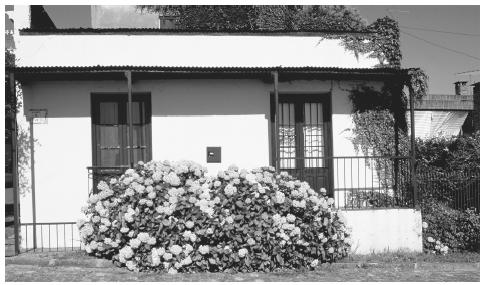
A house on Paseo de San Gabriel. Novo Colonia do Sacramento is a UNESCO World Heritage City.
social, and religious positions are held by men.
Marriage, Family, and Kinship
Marriage. Official marriages have been civil since 1837; marriages are not arranged and are monogamous. About 48 percent of persons older than 15 years old are married, 10 percent live together, 28 percent are single, 4 percent are divorced, 2 percent are separated, and 8 percent are widows and widowers. Serial polygamy is accepted but is not common.
Domestic Unit. Although the typical domestic unit is a nuclear family with one of two children plus the grandparents, extended family networks usually are preserved. Large family reunions are held at least once a year. Authority in the household is divided between the husband and the wife. Many couples live with the parents of the husband or wife, and it is not uncommon for a widowed grandmother to assume the role of a matriarch. Children stay at home until late in life, but older widows and widowers increasingly live alone, to the point where the government has identified old age isolation as a major social and health problem.
Inheritance. Inheritance follows the European ambilinear tradition.
Kin Groups. There are no other kin groups besides the nuclear and informal extended family, except for the symbolic kin system of compadrazgo.
Socialization
Infant Care. Customary practices of infant care and child rearing are essentially identical to those of Europe. It is common for the mother to leave the work force in order to do dedicate more time to child rearing, frequently with the help of grandmothers. Day care centers ( guarderias ) are not as widespread as in the United States.
Child Rearing and Education. Since the 1870s, primary education and secondary education have been based on the French model. Religion was banned from public schools in 1909. All public primary school children wear a white coat and a blue ribbon as a tie. Private school children wear uniforms, that are similar to those in British schools.
Public education is free at all levels, including the university level. This has resulted in an extremely high literacy rate; under 4 percent of males and 3 percent of females older than age ten are illiterate. The average number of years of study per adult is nine to ten.
Higher Education. A university education is highly valued. There are three universities. The Universidad de La República is public and free and specializes in the natural, physical, and medical sciences. The Universidad Católica, which is run privately by the Catholic Church, specializes in the social sciences. The Universidad ORT, associated with the Jewish ORT constructivist educational movement, specializes in technical studies. There are active links with Argentinean and Brazilian universities.
Etiquette
Uruguayans are quite traditional and do not welcome criticism from foreigners. They also do not appreciate being confused with Paraguayans or Argentineans. Otherwise, people are friendly and easygoing. Although tactful, people are frank and direct and maintain a close distance when speaking. Close acquaintances of the opposite sex greet each other with one kiss on the cheek.
A national behavioral particularity is the conspicuous "following gaze" that males direct to females to indicate that they are attractive. In many cases this is accompanied by verbal expressions called piropos, which are sometimes abusive and usually are ignored.
Religion
Religious Beliefs. The church and state have been officially separated since 1917. The constitution protects religious freedom, but people are not devout and daily life is highly secular. More than one-third of the people profess no religion. Approximately 60 percent of the population is nominally Catholic, but only a minority attend church regularly (mostly those in the upper classes). Recently, the Padre Pio revitalization movement has been a source of converts for the Catholic Church.
The Jewish community, which once constituted about 2 percent of the population, is dwindling because of emigration to Israel. There is also a small proportion of people who practice Africanderived religions. Protestants represent less than 4 percent of the population.
Medicine and Health Care
Cardiovascular diseases are the leading cause of death, and hypertension is among the primary causes for medical visits. Dietary factors are implicated in this pattern: fat consumption is very high, and fiber intake is low. A high prevalence of obesity is associated with a high incidence of diabetes. Cancer accounts for 23 percent of all deaths. The high rate of lung cancer is related to the prevalence of smoking, particularly among men. Alcoholism is a problem among men age twenty to forty-nine years, which is associated with a high prevalence of cirrhosis of the liver.
Approximately 60 percent of the population is covered by private nonprofit collective health care associations known as mutualistas. Free coverage through the Ministry of Public Health covers approximately 20 percent of the population, and military and/or police or private company insurance covers approximately 10 percent. The rest of the population has no formal coverage.
Complementary and alternative medicine has not been practiced traditionally. However, in recent years this pattern has been changing (e.g., acupuncture, homeopathy, and herbal medicine).
Secular Celebrations
Traditional Catholic holidays have been secularized and renamed. For example, Christmas is called Family Day and Holy Week is called Tourism Week.
Holidays also celebrated in other Latin American countries include New Year's Day, Carnaval, Worker's Day (1 May), the Day of the Americas (12 October), and the Day of the Deceased (2 November). Holidays related to the nation's history are the 33 Patriots Day (19 April), Battle of Las Piedras (18 May), José Artigas's Birthday (19 June), Constitution Day (18 July), and Independence Day (25 August).
The Arts and Humanities
Support for the Arts. Artists are self-supporting, but receive some funding from the government and private institutions. The Ateneo de Montevideo is a meeting place for those involved in artistic and humanistic activities.
Literature. Among the most important writers are José Enrique Rodó, a philosophical essayist; Juan Zorrilla de San Martín, the author of Tabaré, an epic poem about a heroic Charrúa mestizo; Horacio Quiroga, a modernist short story writer; and José Alonso y Trelles, who wrote about the gauchos. Female poets include Delmira Agustini and Juana de Ibarbourou. More recent writers include Mario Benedetti,
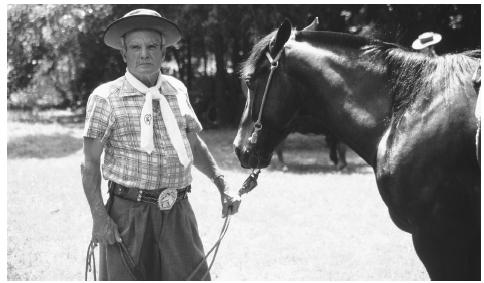
The gaucho is symbolic of the Uruguayan nationality. Rural gauchos still wear the traditional garb as seen above.
Eduardo Galeano, and Juan Carlos Onetti and Tessa Bridal (who wrote the novel The Tree of Red Stars, a depiction of the national culture in the 1960 and 1970s).
Graphic Arts. There are many museums and galleries. Some of the best known painters are Juan Manuel Blanes, a realist known for historical paintings and gaucho motifs; Pedro Figari, a postimpressionist who specialized in bucolic colonial and early twentieth-century scenes (including aspects of black Uruguayans' life); and Joaquín Torres Garcia, a constructivist. Renowned sculptors include José Belloni, José Luis Zorrilla de San Martín, and Edmundo Prati.
Performance Arts. The Teatro Solis and the El Galpón theater are important sites for theatrical and musical presentations. Among classical composers, Eduardo Fabini is the best known internationally. Many musical and dance traditions derive from Europe, with local variations. Others are native to Uruguay and Argentina, particularly the tango. Uruguay was the birthplace of Carlos Gardel, the most famous interpreter of the tango.
There are many folkloric musical styles and dances, such as Pericón (the national dance). Another important musical style is candombe. This is a typical Afro-Uruguayan musical style played with three kinds of drums. These drums are crafted individually, and each is said to have a unique sound. Candombe can be heard throughout Montevideo during the February Carnaval, when ensembles of marching drummers cruise the streets. Llamadas are parades of competing groups of dancers who move to the rhythm of the candombe (the public is also welcome to join the dancers). These events are typical of the neighborhoods where most Afro-Montevideans live. Carnaval includes other cultural expressions, such as murgas which are musical groups that make fun of the social and political events of the year.
The State of the Physical and Social Sciences
Most research in the sciences and humanities is done in the universities, museums, and government institutions. Research budgets are clearly insufficient.
Bibliography
Davis, William C. Warnings from the Far South, Democracy versus Dictatorship in Uruguay, Argentina, and Chile, 1995.
Ferguson, J. Halcro. The River Plate Republics, Argentina, Paraguay, Uruguay, 1965.
Fitzgibbon, Russell H. Uruguay, Portrait of a Democracy, 1966.
Gilio, Maria E. The Tupamaro Guerrillas, 1972.
Hudson, Rex A., and Sandra W. Meditz, eds. Uruguay: A Country Study, 2nd ed., 1992.
Pan American Health Organization. Health in the Americas, 1998.
Pendle, George. Uruguay, 1965.
Sans, Mónica, et al. "Historical Genetics in Uruguay: Estimates of Biological Origins and Their Problems." Human Biology 69 (2): 161–170, 1997.
Weinstein, Martin. Uruguay, the Politics of Failure, 1975.
Zum Felde, Alberto. Evolución Histórica del Uruguay y Esquema de su Sociología, 1941.
——. Proceso Intelectual del Uruguay, Crítica de su Literatura, 1967.
